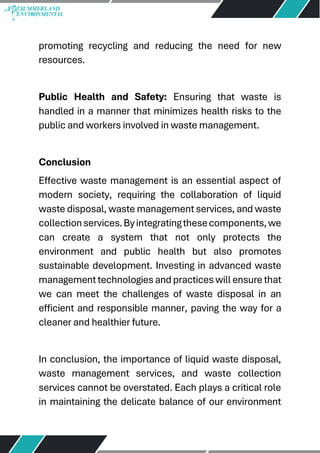The Basic Principles Of Reclaim Waste
The Basic Principles Of Reclaim Waste
Blog Article
Reclaim Waste Can Be Fun For Everyone
Table of ContentsThe Buzz on Reclaim WasteSome Ideas on Reclaim Waste You Should KnowIndicators on Reclaim Waste You Should KnowHow Reclaim Waste can Save You Time, Stress, and Money.Reclaim Waste for Beginners
Discover the types, events, and kinds of fluid waste. Domestic sewage waste refers to the waste and products from a domestic septic system. This kind of waste is created by humans in residences, institutions, and other buildings. This only consists of septic containers that have a drain field. The appropriate monitoring and disposal of domestic sewage waste call for fluid waste to be transferred to a sewage therapy plant where the proper techniques and equipment are related to detoxify and take care of waste.
Commercial waste typically consists of possible dangers, such as flammable products or a combination of liquid and solid waste items, and needs a much more innovative and comprehensive disposal procedure. The disposal of commercial waste commonly involves the filtering of waste prior to transportation to ensure secure and appropriate disposal. Hazardous waste is developed from byproducts and overflow of industrial processes and manufacturing.
This sort of waste can not use the same sewer administration transport or procedures as septic or commercial liquids. The industrial waste administration process needs the inspection and screening of fluid waste before it undergoes the disposal process (industrial wastewater treatment). Overflow waste is the liquid waste that originates from overflow and excess stormwater in extremely populated areas or cities
Runoff waste can cause contamination and flooding if not taken care of appropriately. Guaranteeing appropriate waste management can protect against disasters and minimize environmental injury.
Our Reclaim Waste Ideas
Call PROS Solutions today to discover our waste management and disposal services and the appropriate methods to care for the fluid waste you generate.
(https://leonaube33101.wixsite.com/reclaim-waste/post/effective-liquid-waste-removal-and-disposal-everything-you-need-to-know)Do you know what takes place to your water when you disengage, purge the toilet or drain pipes the washing machine? No? Well, it deserves knowing. This supposed 'wastewater' is not only a vital source yet, after therapy, will be launched to our land, rivers or the ocean. Made use of water from bathrooms, showers, bathrooms, kitchen area sinks, washings and industrial procedures is understood as wastewater.

water used to cool down machinery or tidy plant and equipment). Stormwater, a type of wastewater, is overflow that moves from farming and city areas such as roofs, parks, gardens, roadways, courses and rain gutters into stormwater drains pipes, after rain. Stormwater streams untreated straight to local creeks or rivers, ultimately getting to the sea.
What Does Reclaim Waste Mean?
In Queensland, most wastewater is treated at sewer treatment plants. Wastewater is moved from domestic or commercial websites via a system of sewage systems and pump stations, referred to as sewage reticulation, to a sewer treatment plant. Local federal governments develop, maintain and run most sewer therapy plants. Operators are licensed under the Environmental Management Act 1994 to release treated wastewater at an appropriate ecological standard into waterways.
The Division of Natural Resources recommends local federal governments regarding managing, operating and keeping sewage systems and therapy plants. In unsewered areas, city governments might need owners to install individual or household sewage therapy systems to treat residential wastewater from bathrooms, kitchens, bathrooms and laundries. The Division of Natural Resources authorises the use of house systems when they are confirmed to be efficient.
In some brand-new communities, therapy of some stormwater to remove trash, sand and crushed rock has started using gross toxin traps. Wastewater therapy occurs in 4 stages: Gets rid of strong matter.
Utilizes little living microorganisms knows as micro-organisms to damage down and get rid of remaining dissolved wastes and great fragments. Micro-organisms and wastes are incorporated in the sludge.
Not known Factual Statements About Reclaim Waste
Nutrient removal is not readily available at all sewage therapy plants since it needs expensive specialist equipment. Clear liquid effluent generated after therapy might still contain disease-causing micro-organisms - liquid waste disposal melbourne.

This generally means wastewater has to be dealt with or pollutants eliminated before it can be released to waterways. Most wastewater flows right into the sewage system. Under the Act, local governments carry out approvals and licences for ecologically appropriate tasks (Ages) including wastewater releases that could have a regional impact. The division provides approvals and permits to ERAs entailing wastewater releases that may have a local or statewide impact.
Things about Reclaim Waste
Monitoring supplies valid information about water top quality and can confirm that licence conditions are being met. The information obtained through monitoring offers the basis for making water high quality choices.
Report this page